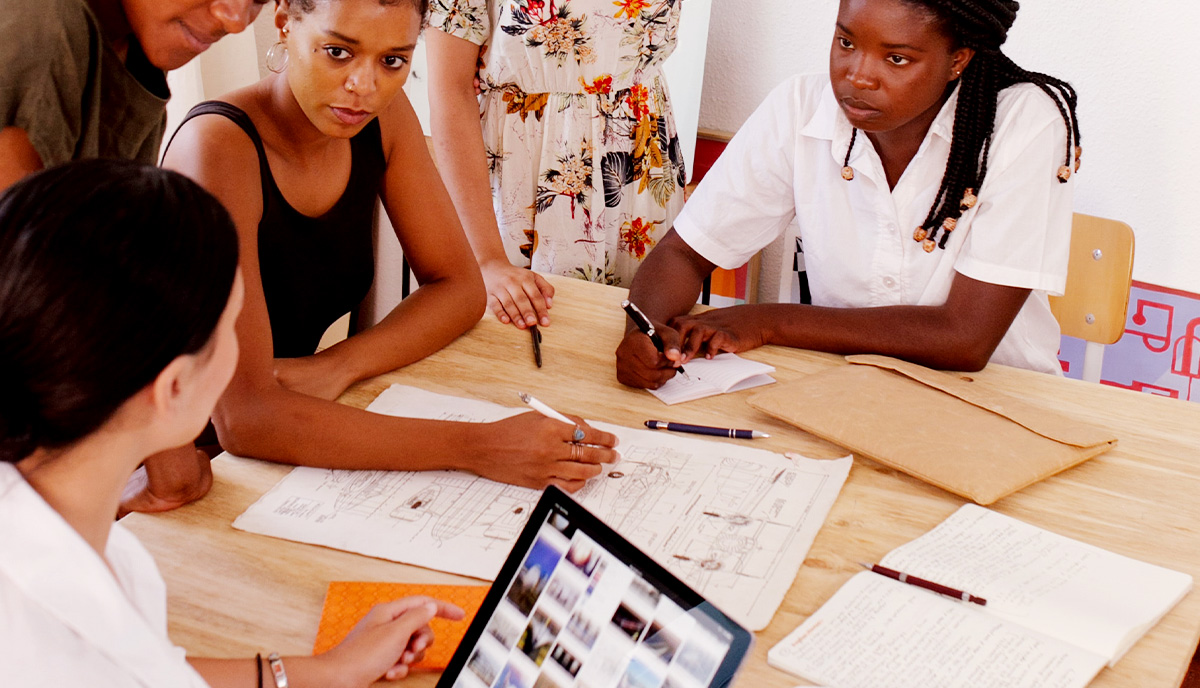Your complete guide to creating print-ready files
Image by RF._.studio via Pexels.com
How do I prepare a file for print production?
It’s always nerve-wracking, getting ready to deliver those final print-ready files. Any errors can cause all kinds of problems down the line. But stay calm, take a deep breath, and let us take the fear out of getting those files ready for the printer. We’ve been doing this for decades, so we understand. What’s more, we can help. This guide will take you step-by-step through preparing your files for printing.
Keep calm about color — we’ve got your back!
We’ll start with color, just because it’s one of the factors that seems to cause most anxiety. The key is to make sure that you’re working in the correct color system. So, to make it simple:
- When your designer works in color on the computer, they’ll use the RGB system. RGB just stands for red, blue, and green. Using these basic colors, the system can generate millions of variations in hue and shade.
- But your custom printer’s press uses another system, a four-color process called CMYK. It stands for cyan, magenta, yellow, and black.
- On occasion, you may need colors that can’t be created by either of these systems. In that case, you need to talk to your printer about ‘spot colors’ which must be specially created for your project. But 99% of commercial projects don’t need that level of customization.
What all this means is that before submitting your finished files for printing, you’ll need to convert them from RGB to CMYK. These different systems are known as “color spaces” in printing jargon. How easy it is to do depends on the program used. Most are straightforward, with the option to choose between spaces with a few simple clicks. Others are a bit more convoluted, and a few can’t do it at all and so you’ll need your printer to do it for you.
But it’s usually in your interest to do the conversion yourself if you can. The only reason is that it makes for a smoother and faster print turnaround and gives you complete control over how your images come out. At QinPrinting, we’re always happy to talk to you, support you, and advise you every step of the way, so if you have any doubts, just ask us and our expert team will guide you through what you need to do to get your color files ready.
Certain colors don’t translate. This is true across the board and just one of the factors that we all need to live with when designing on a computer and mass printing to paper with a press. With a photographic image, any differences of this nature are likely to be so slight that even the keenest visual artist wouldn’t notice. But for your core branded graphics — such as logos — we’d recommend generating them in CMYK from the outset.
How to convert color files from RGB to CMYK
To make this super-easy for you, let’s go through the most common programs and show you step-by-step how to convert your files from RGB to CMYK. If you have a different iteration of the software, don’t worry. These are processes which are so fundamental that they’re conserved even in new versions. Again, if you have any concerns, just talk to us — we’re always happy to help.
Microsoft Publisher
Microsoft Publisher 2000 uses RGB as its default color space. Fortunately, it’s very simple to convert to CMYK using Publisher. Here’s how you do it:
- Go to ‘Tools’, then click ‘Commercial Printing Tools’, then go to ‘Color Printing’
- Click on ‘Process Colors (CMYK)’
Pretty much, that’s it. The only thing to note is that you must incorporate images as links in a layout. If you embed them, they may not support the new CMYK color space. If you add links, don’t forget to send the images as well as the layout.
In later versions of Microsoft Publisher, it’s easier. Just go to the file tab and click ‘info’. Then, ‘Commercial Print Settings’ and ‘Choose Color Model’. Finally, click ‘Select Process Colors (CMYK)’ and you’re good to go.
Photoshop
In Adobe’s Photoshop, it couldn’t be easier. You can work directly in the CMYK space by choosing the CMYK mode option at the outset. If you have a file in RGB you need to convert, just go to ‘Image’ on the menu and then change the mode to CMYK. Once you’re happy, click ‘OK’ and you’re done.
Corel Draw
You have two possibilities here. If your image/object is without an outline, just select it. Go to the ‘fill’ tool and click on the ‘fill color’ option and choose CMYK. If there’s an outline, go to the ‘select outline’ tool, click the ‘outline color’ dialog and choose CMYK. That’s it.
Illustrator
If you use Adobe Illustrator, just select your document and choose the CMYK color mode. How easy was that?
Quark Xpress
It’s a bit more convoluted in QX. This is what you need to do:- Go to ‘Edit’
- Click ‘Edit Colors’
- Click ‘Show Colors in Use’
- Go to ‘Highlight Color’
- Click on ‘Edit’
- Choose CMYK as the model and remember to deselect ‘Spot Color’
InDesign
Adobe’s InDesign is a powerful software but the most complex for switching color spaces. Still, take it step by step and you shouldn’t encounter any difficulties. Here’s what to do:
- In the menu, choose Window/Swatches
- Then select Window/Color and double click
- Make CMYK the color mode
- Select ‘process’ as the type
But remember that if you’ve got colors in the document that aren’t represented in the swatches palette, you’ll need to select each object and manually check and adjust the percentages to align with CMYK.
Image resolution for print quality
Print demands high quality images, and that means the resolution must be correct for clear reproduction. In the digital format, resolution is measured in DPI (dots-per-inch). For print, you must make sure that your images have a resolution of 300 DPI or more. Even if the images look great on the computer screen, it’s vital to check and adjust the resolution if you want them to look just as good in print, too.
Also, keep in mind that if you resize an image within your layout, you’ll change the resolution, too. Making an image smaller reduces the DPI. Making it larger adds in extra data but can change the image quality. If you up- or downsize an image by altering the pixel density, make sure that the final result has a PPI (pixels-per-inch) of at least 300. While JPEG image format is popular for photographs during design, converting photo images to PNG or TIF usually gives the best results for printing. However, your text and line drawings or logos should be formatted as vectors (AI, SVG, or EPS).
Bleed dimensions, folds, and trimming
Often, you’ll want your layout to ‘bleed’. All this means is that the image or color background ‘bleeds’ out beyond the final trimmed dimensions of the printed document. Bleed sizes may vary but will typically allow for about 0.125 inches outside the trim space.
Leaflets, brochures, catalogs, booklets, and other projects may all have folds. You must account for any folds when designing your layout so as not to lose important elements from images or text. The easiest way to account for folding is to generate a prototype of the design space and measure out a ‘safe’ area within which you can position all your content.
Your final print product will be cut and trimmed. Talk to your printer about the specific requirements for your project to make sure that your bleed and safe space dimensions are correct. That way, you’ll make sure that your design is properly positioned on the page and nothing gets lost or cut off.
If you’re unsure what bleed, safe space, and trim margins you need, just talk to us and we’ll help you through.
Binding and pagination
Books, catalogs, brochures, and magazines need binding to hold the pages together. Whether using coil or wire binding, perfect binding or saddle stitch, to make sure your pages come out in the right order, you’ll need to think about pagination. Your design software may have the option to switch between document views. But don’t worry about changing to a printer spread. Submit a reader spread file to your printer and they can handle the pagination for you. But remember to include any blank pages in the spread. We can give you a template suitable for your binding choice and we’ll always provide a proof for you to check before going to press.
Custom effects, paper options, and ink
If you’d like to enhance your print product with custom effects such as embossing, debossing, die cutting, and foil stamping, make sure to talk with your printer. These are specialized design elements and will also influence your choice of paper. When choosing paper, you’ll need to take account of several factors, including the size of your document, the number of pages, effects, and the binding style. Paper has three fundamental qualities:
- weight
- finish
- and coating
Paper with a higher weight is thicker and more robust. It’s also more expensive. Lower weight paper is thinner and cheaper. Choosing paper weight is a balancing act between cost effectiveness, printing requirements, binding style, and the desired overall effect.
A paper’s finish refers to its texture. Papers may be rougher or smoother. Paper with a more textured finish is popular for certain stationary or packaging projects. Smoother paper is the usual choice for printing most flyers, leaflets, brochures, catalogs, and books.
Paper can be coated or uncoated. Uncoated paper makes the ink look duller and is more absorbent and prone to smudging — if it gets wet, for example. Coated paper may be gloss or matte and makes colored inks appear more vibrant. It also fixes the ink better, so it’s less likely to smudge. There are also more specialized coatings involving UV and varnish for a very glossy or deep matte effect, more often used for covers as they also offer added protection.
Preparing your files to send to the printer
In most cases, your print-ready files should be exported in PDF pages format. Remember to include blank pages. Together with your text layout, remember to include all your images and photos as PNG or TIF files resolved to 300+ DPI/PPI for photographs and line drawings/logos as vectors. Zip it all together and mail it to your printer. If the file’s too big to go through as an attachment, via the Cloud using a file sharing service such as Google Docs or Drop Box.
Your printer is your friend — talk to them!
Whatever your project, it’s never too soon to talk to your printer. If you choose us, we’re only a phone call away. With decades of experience in the industry, one of our expert team will be happy to help and guide you as you prepare your files for printing and we have all kinds of useful resources — such as templates, tables, and more — to make your life even easier. Get in touch today for a no-obligation quote or to talk through what you have in mind.


